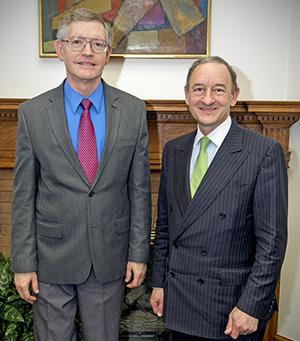
Moerner shares the award, announced Oct. 8 by the Royal Swedish Academy of Sciences, with Eric Betzig, PhD, of the Howard Hughes Medical Institute, and Stefan W. Hell, PhD, of the Max Planck Institute for Biophysical Chemistry, in Germany. The trio received the award for developing super-resolved fluorescence microscopy.
“Washington University is extremely proud that our distinguished alumnus W. E. Moerner has received the highest international prize in his field,” said Chancellor Mark S. Wrighton. “Dr. Moerner’s pioneering research paved the way for scientists worldwide to see individual molecules inside a living cell, a breakthrough that will help solve a multitude of scientific problems. We congratulate him and his fellow laureates on the recognition of this important work.”
Moerner is the Harry S. Mosher Professor of Chemistry and professor, by courtesy, of applied physics at Stanford University. His research focuses on physical chemistry, chemical physics, single-molecule biophysics, super-resolution imaging and nanoparticle trapping.
Moerner earned three bachelor’s degrees, all with honors, from Washington University in 1975. His bachelor’s degrees are in physics and in mathematics, both from Arts & Sciences, and in electrical engineering from the School of Engineering & Applied Science. He earned master’s and doctoral degrees in physics from Cornell University.
Moerner, a native of San Antonio, was an Alexander S. Langsdorf Engineering Fellow at Washington University. He also received the Dean’s Award for Unusually Exceptional Academic Achievement and the Ethan A. H. Shepley Award for Outstanding Achievement.
In 2013, the School of Engineering awarded him an Alumni Achievement Award.
In his acceptance speech at the awards dinner in 2013, he specifically mentioned the Langsdorf fellowship, which allowed him to attend the university and “break out and expand into so much more,” and the mentorship of his professors.
About Moerner’s work
Moerner’s work was instrumental in the development of what the media is already calling super microscopes or nanoscopes. For most of the 20th century, scientists believed that they would never be able to see things smaller than roughly half the wavelength of light, called a diffraction limit, with an optical microscope. This took them down to the level of the mitochondrion, an organelle in the cell that kicks out energy for cellular processes, but still left them unable to see proteins, which carry out most of the cell’s work.
The Nobel Committee said this was like being able to see the buildings of a city without being able to track what any of its citizens were doing.
Moerner and his colleagues discovered that fluorescent molecules allowed them to bypass the diffraction limit. In 1989, Moerner became the first scientist in the world to measure the light absorption of a single molecule with the first published report of single-molecule detection and spectroscopy in condensed phases. [“Optical Detection and Spectroscopy of Single Molecules in a Solid,” by W. E. Moerner and L. Kador, Phys. Rev. Lett. 62, 2535 (1989).]
Eight years later, he discovered that the fluorescence of a variant form of a green protein isolated from a fluorescent jellyfish could be turned on and off at will by exciting it with light of different wavelengths.
He dispersed the excitable proteins in a gel separating each of them by more than the diffraction limit. They were like tiny lamps with switches, the Nobel Committee said, and dispersed in this way they could be seen with a regular optical microscope.
The results were published in the scientific journal Nature in 1997.
Betzig then used Moerner’s molecules to build a microscope able to resolve one molecule, publishing the result in Science in 2006.
All three laureates have gone on to use their nanoscopes to watch the molecules of life at work in the cell. Moerner, for example, recently used them to examine Huntington, the misfolded protein that causes the neurodegenerative disease that killed singer Woody Guthrie.
To peer through Moerner’s nanoscope, check out the top movie at Moerner’s movie site. It shows fluorescent shellfish toxin (saxotoxin) binding to individual sodium ion channels on nerves. By binding to the sodium channels, saxotoxin prevents nerves from firing causing death by respiratory failure.
Diana Lutz, Leslie McCarthy and Beth Miller contributed to this story.